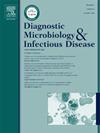Peptoniphilus vaginalis bacteremia in a patient with diabetic foot infection: First reported case and literature review
IF 2.1
4区 医学
Q3 INFECTIOUS DISEASES
Diagnostic microbiology and infectious disease
Pub Date : 2025-03-09
DOI:10.1016/j.diagmicrobio.2025.116794
引用次数: 0
Abstract
Background
Peptoniphilus vaginalis, a Gram-positive anaerobic coccus, is a recently characterized species within the Peptoniphilus genus. No studies have detailed its features. This report documents the first case of P. vaginalis bloodstream infection in a patient with diabetic foot infection, with a review of existing literature.
Case presentation
A 55-year-old male presented with multiple skin ulcers on both lower extremities and hyperpyrexia. Blood cultures were conducted, and analysis via matrix-assisted laser desorption/ionization time-of-flight mass spectrometry (MALDI-TOF MS) revealed two distinct colony morphologies, namely Peptoniphilus spp. and Staphylococcus epidermidis. Discrepancies between MALDI-TOF MS results and biochemical identification prompted 16S rRNA sequencing, which confirmed P. vaginalis. The patient underwent surgical debridement and received intravenous antibiotics (levofloxacin, linezolid, and ornidazole), resulting in favorable recovery.
Conclusions
This is the first report of P. vaginalis bloodstream infection in a patient with diabetic foot infection. It was observed that conventional biochemical identification methods and MALDI-TOF MS technology may not reliably detect P. vaginalis. In the absence of more advanced molecular methods, P. vaginalis could potentially be misidentified as Peptoniphilus harei, even in the previously published literature. Catalase testing may serve as a pragmatic discriminator in resource-limited settings, which required further validation. This underscores the necessity for employing molecular biology techniques to ensure precise diagnosis and optimize treatment strategies.
1例糖尿病足感染患者阴道胃杆菌菌血症:首次报道并文献复习
背景阴道胃杆菌是一种革兰氏阳性厌氧球菌,是胃杆菌属中新近发现的一种。没有研究详细说明其特征。本报告记录了首例阴道假单胞菌血流感染的糖尿病足感染患者,并对现有文献进行了回顾。病例表现男性,55岁,双下肢多处皮肤溃疡伴高热。进行血液培养,通过基质辅助激光解吸/电离飞行时间质谱(MALDI-TOF MS)分析发现两种不同的菌落形态,即嗜胃杆菌和表皮葡萄球菌。MALDI-TOF MS结果与生化鉴定结果差异提示16S rRNA测序,证实为阴道假单胞菌。患者行手术清创并静脉注射抗生素(左氧氟沙星、利奈唑胺、奥硝唑),恢复良好。结论在糖尿病足感染患者中首次发现阴道假单胞菌血流感染。传统的生化鉴定方法和MALDI-TOF MS技术不能可靠地检测出阴道假单胞菌。在缺乏更先进的分子方法的情况下,即使在先前发表的文献中,阴道假单胞菌也可能被误认为是哈氏胃杆菌。在资源有限的环境中,过氧化氢酶测试可以作为一种实用的鉴别方法,这需要进一步的验证。这强调了使用分子生物学技术来确保精确诊断和优化治疗策略的必要性。
本文章由计算机程序翻译,如有差异,请以英文原文为准。
求助全文
约1分钟内获得全文
求助全文
来源期刊
CiteScore
5.30
自引率
3.40%
发文量
149
审稿时长
56 days
期刊介绍:
Diagnostic Microbiology and Infectious Disease keeps you informed of the latest developments in clinical microbiology and the diagnosis and treatment of infectious diseases. Packed with rigorously peer-reviewed articles and studies in bacteriology, immunology, immunoserology, infectious diseases, mycology, parasitology, and virology, the journal examines new procedures, unusual cases, controversial issues, and important new literature. Diagnostic Microbiology and Infectious Disease distinguished independent editorial board, consisting of experts from many medical specialties, ensures you extensive and authoritative coverage.

 求助内容:
求助内容: 应助结果提醒方式:
应助结果提醒方式:


